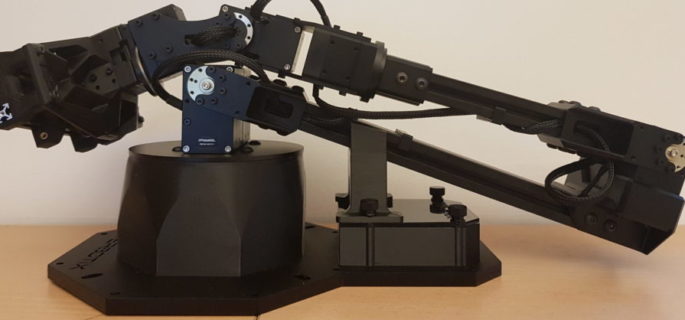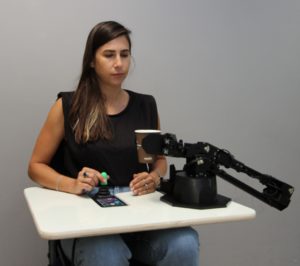Neuromorphic Computing to Assist Children Who Use Wheelchairs

Intel’s neuromorphic chip has learned to smell, learned to touch – and now, it’s here to help. The chip, which mimics the behavior of the human brain, is being used in a collaborative effort to develop a wheelchair-mounted assistive robotic arm for pediatric patients with spinal injuries, helping them to more easily navigate the challenges of daily life.
Tens of millions of people around the world require wheelchairs, and many of those have upper body impairments that make basic tasks (like grabbing objects or writing) exceedingly difficult. Robotic arms can assist these people, but their exorbitant costs are prohibitive for many potential users. To help bridge this accessibility gap, the Neuro-Biomorphic Engineering Lab at the Open University of Israel, in collaboration with ALYN Hospital in Israel, began a project through the Intel Neuromorphic Research Community (INRC).
The researchers posit that the high cost of current assistive robotics is largely attributable to two factors: the first, high power consumption (which also necessitates frequent recharging); and the second, highly specialized, expensive parts used in the construction of the arms. The project aims to use Loihi, Intel’s fifth-generation neuromorphic chip, to address these barriers. Loihi’s 128 cores (each with a built-in learning module) host 131,000 virtual “neurons” that behave in a similar way to neurons in the human brain, allowing the chip to more easily process stimuli.
The team, which is now being assisted by researchers from Intel Labs, Accenture Labs and Applied Brain Research (ABR), sees a number of advantages in a neuromorphic approach to assistive robotics. Loihi operates up to a thousand times more efficiently than standard processors, offering potentially enormous benefits to energy costs and inconveniences. Furthermore, the researchers have shown fewer errors in complex path navigation when pairing neuromorphic chips with the recurrent error-driven adaptive control hierarchy (REACH) algorithm upon which they are building their new system.

A member of the research team at ALYN Hospital demonstrates the assistive robotic arm. Image courtesy of ALYN Hospital.
Elishai Ezra Tsur, lead project researcher at the Open University of Israel, explained that the support from Accenture, Intel and ABR “is allowing us to explore the implementation of adaptive controls on neuromorphic hardware in an effort to address the need for a collaborative, user-friendly, accurate robotic arm at a significantly reduced cost.”
“Neuromorphic computing is a natural fit for assistive technologies, given its low power requirements and ability to learn and adapt to new situations in real time,” said Mike Davies, director of Intel’s Neuromorphic Computing Lab. Combined, these two advantages would also allow the researchers to use less expensive components for the arm – in total, they estimate, reducing the cost more than tenfold, all while improving functionality.
Once the algorithmic work is complete and tested on the Loihi-equipped arm (which has already been constructed), the researchers are planning to evaluate and test the assistive system with children who use wheelchairs at ALYN Hospital, a pediatric and adolescent rehabilitation facility located in Jerusalem.
“We believe that the development of a robotic arm based on neuromorphic computing can be a game-changer for people with disabilities,” said Arie Melamed-Yekel, general manager of ALYNnovation, ALYN’s entrepreneur- and inventor-facing assistive technology program. “It could make it easier for them to engage with the community, boost their independence and grant them new employment opportunities. The expected cost and performance improvements are potentially disruptive to this market. We are proud to lead this revolution together with the Open University, Intel and Accenture.”
The researchers are already looking ahead, with eyes toward mass production for patients, as well as applications outside of the medical field, such as manufacturing and industrial automation.
“This research project is a powerful demonstration of the impact that neuromorphic computing can have on the development of affordable intelligent assistive devices,” said Edy Liongosari, technology innovation growth and strategy lead and chief research scientist at Accenture. “Making these devices accessible, particularly to such young patients, can have a profound impact on their independence, improving the way they live.”










